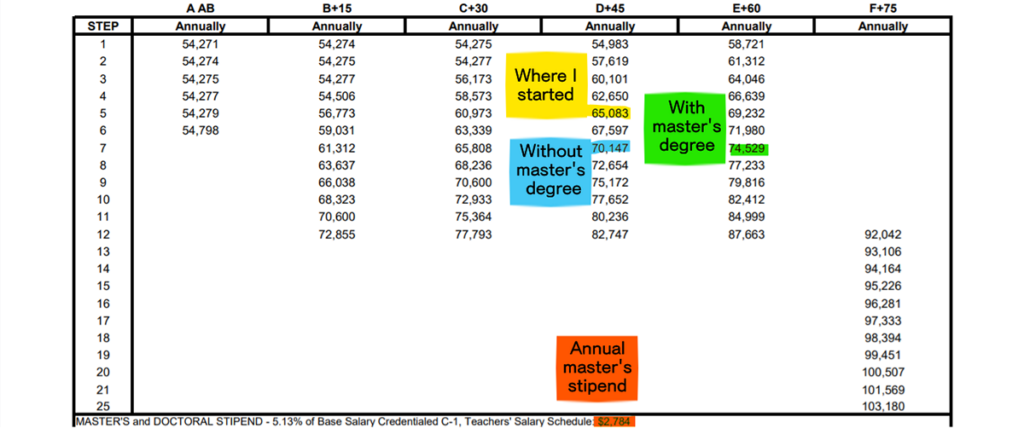If you plan to stay in the classroom, you may wonder if it is worth it to go “back to school” and get your master’s degree. There are probably a whole host of factors and questions that spring up for you. Plenty of research has already been done about the benefits of holding a master’s degree when working in education. There are even debates about the merits of holding a master’s in education versus a master’s in teaching or whether master’s degrees improve teacher efficacy. But when you pare all the factors down, the one that most likely sticks out is about money—is it financially worth it?

In this article, we are doing the math to examine the financial impact of attaining a master’s degree as an art educator.
Math is not my strong suit, so I brought in a math teacher and former financial advisor to help me. There is no shame in asking for help, especially from an expert! I’ll share the diagrams she made with me below. For all of you fellow visual learners, color-coding helps a lot!
It’s important to remember that some states require their K-12 educators to hold a master’s degree. If you plan to teach in one of the states requiring a master’s degree, you may need to get one anyway. If you are considering which state you would like to teach in, be sure to check the credentialing requirements to ensure that you get into the classroom as quickly as possible!
Now, let’s do some math.
Disclosure: This author holds a Master of Arts in Art Education from The Art of Education University. While this article is not meant to highlight the program, it is used as an example.

To figure out the financial benefits of getting a master’s degree while working in your district, you will need a few things:
- The salary schedule for your district
- The master’s stipend for your district
- Clarity on if stipends are one-time or annual
- The tuition costs for your intended program
- Information on if your district offers tuition assistance and how much
For this example, I will use a salary schedule for a district in California and the current number for the cost of a master’s degree from AOEU, which is $15,064. (The national average for a Master’s in Education is $55,200.) Also, some districts do not provide master’s stipends, and some provide it under specific stipulations. Others offer them to any teacher holding a master’s degree. Make sure you do your research so you can have the most up-to-date information on what your district provides.
Once you have gathered all your data, you will want to analyze the cost of the degree, the master’s stipend, and how it shifts you on the pay scale. This data will help you figure out how many years it will take to get your degree paid off.

Let’s look at a scenario where I continue my career without a master’s degree.
Let’s say I am at D+45 and Step 5, which is $65,083 on the salary schedule. In two years without a master’s degree, I will be at D+45 (since I haven’t taken any more credits) and Step 7 (to denote two more years). I will earn $65,800.
Let’s look at a scenario where I complete my master’s degree.
Starting at the same spot, let’s say I am at D+45 and Step 5, which is $65,083 on the salary schedule. I know the master’s degree will take about two years. After finishing my master’s program, I can predict that I will move to the E+60 column because I will have completed 60+ credits as part of the program. I will also move down to Step 7 because I will have been teaching for seven years. I can predict that at this point I will be at $74,529. This district also offers a master’s stipend, noted at the bottom of the table. For this district, it is an additional $2,784 per year.

But the master’s degree is expensive! Is the increase in pay worth the cost?
The cost of a master’s degree from AOEU is currently $15,064. The district in our scenario does not offer tuition assistance. If you can receive tuition assistance, subtract the assistance amount from the cost of the degree.
With a master’s degree at the E+60 column and Step 7, the salary will be $74,529 with an annual master’s stipend of $2,784. With each additional year of teaching, the salary will increase by approximately $2,000. With the increases in columns, steps, and stipend, I will break even on the $15,064 tuition for the master’s program in just about two years! Additionally, because I will hold a master’s, I will move to the F+75 column after twelve years of teaching. This means less stress later in my career and that the financial cost of pursuing a master’s degree is well worth it in the long run.
Now it’s your turn!
It’s time to take a moment, sit down, and do your own math. If your salary schedule is not as straightforward as the one used in the above example, AOEU has a handy Return on Investment calculator you can use. If you still need help, ask a friend!

Thinking about finances and the future can be stressful. It is tempting to procrastinate and put it off until “next year.” Just because we don’t want to do the math or plan ahead, doesn’t mean we should shy away from growing in our careers. In most instances, pursuing a master’s degree is a financial improvement for teachers. If you can afford the tuition, maybe now is the time to go get that degree. Teachers often put the needs of others before their own. It’s time to invest in yourself so you can be the best art teacher that you can be!
If you are looking for a master’s program that will be relevant to you as an art teacher, look into the Art of Education University’s Master of Arts in Art Education. This is a 100% online degree program designed specifically for art teachers by art teachers. It features both teaching philosophy and hands-on studio courses that will translate right into your art room.
Have you considered getting a master’s degree? What is holding you back?
How will you invest in yourself this next calendar year?
Magazine articles and podcasts are opinions of professional education contributors and do not necessarily represent the position of the Art of Education University (AOEU) or its academic offerings. Contributors use terms in the way they are most often talked about in the scope of their educational experiences.





